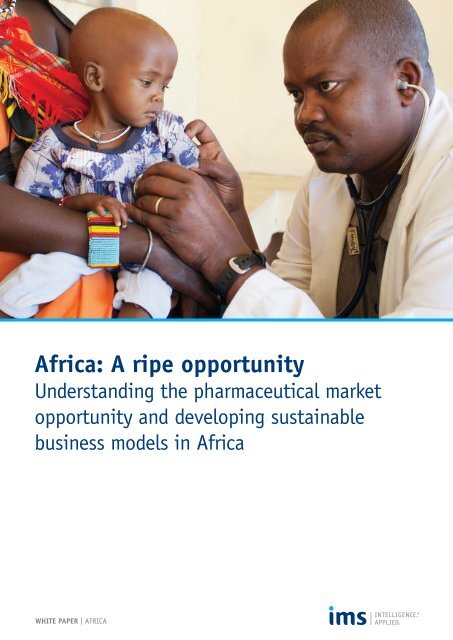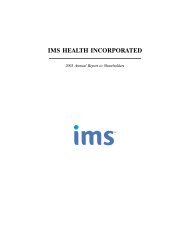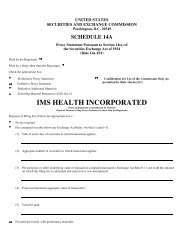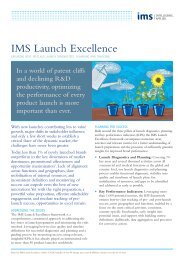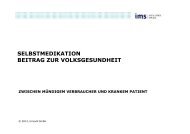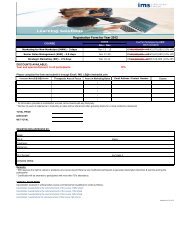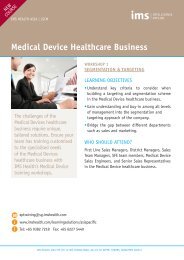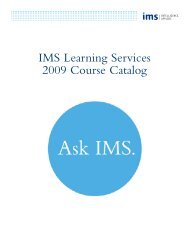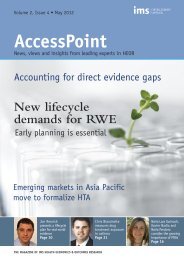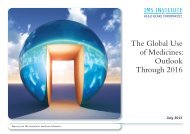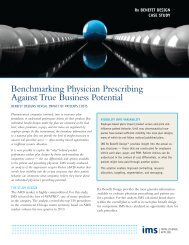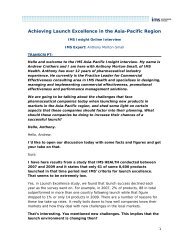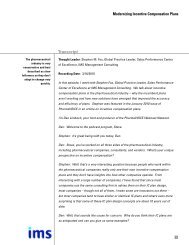Africa: A ripe opportunity - IMS Health
Africa: A ripe opportunity - IMS Health
Africa: A ripe opportunity - IMS Health
Create successful ePaper yourself
Turn your PDF publications into a flip-book with our unique Google optimized e-Paper software.
<strong>Africa</strong>: A <strong>ripe</strong> <strong>opportunity</strong><br />
Understanding the pharmaceutical market<br />
<strong>opportunity</strong> and developing sustainable<br />
business models in <strong>Africa</strong><br />
WHITE PAPER | AFRICA
WHITE PAPER | AFRICA<br />
As growth opportunities continue to move away from the traditional<br />
pharmaceutical markets, most multinationals have <strong>Africa</strong> in the sights of<br />
their expanding global footprint. It is a continent <strong>ripe</strong> with potential, but<br />
the challenges for developing a viable market strategy are formidable.<br />
Understanding the dynamics and underlying demographics will be key to<br />
ensuring a sustainable business model for the future.<br />
<strong>IMS</strong> <strong>Health</strong> has conducted a study combining <strong>IMS</strong> intelligence with secondary<br />
research and primary interviews with the pharmaceutical industry,<br />
international and <strong>Africa</strong>n organizations. The study explores critical questions<br />
that companies are asking in entering or optimizing their presence in <strong>Africa</strong>:<br />
Why is investing strategically important? Where are the major opportunities?<br />
And what will it take to be successful in this fast-evolving region?<br />
AFRICA WILL BE A SIGNIFICANT ECONOMIC FORCE IN THE FUTURE AND PHARMACEUTICAL<br />
COMPANIES HAVE MUCH TO GAIN<br />
By 2016, pharmaceutical spending in <strong>Africa</strong> is expected to reach US$30 billion.<br />
This value is driven by a 10.6% compound annual growth rate (CAGR) through 2016,<br />
second only to Asia Pacific (12.5%) and in line with Latin America (10.5%) during this<br />
period. Spurred by a convergence of demographic changes, increased wealth and<br />
healthcare investment, and rising demand for drugs to treat chronic diseases,<br />
this market potentially represents a US$45 billion <strong>opportunity</strong> by 2020.<br />
The pharmaceutical growth is a reflection of economic strength accompanied by<br />
increasing healthcare spending. Sub-Saharan <strong>Africa</strong> (SSA), excluding South <strong>Africa</strong>, is<br />
notable in this regard: according to the Economist Intelligence Unit, its economies are<br />
growing faster than anywhere else in the world and this trend is expected to continue. 1<br />
The appeal of <strong>Africa</strong> lies not in its size – the continent accounts for just 3% of the global<br />
economy – but in the dynamics that drive sustainable growth at a time when the major<br />
established pharmaceutical markets face a more uncertain future. 1 Underpinning these<br />
prospects are a series of positive economic trends: greater political and fiscal stability and<br />
improvements in pro-business legislation have led the United Nations (UN) to forecast<br />
that Foreign Direct Investment (FDI) in <strong>Africa</strong> could more than double by 2014, despite<br />
speculative money leaving the continent following the collapse of Lehman Brothers, and<br />
the Arab Spring restricting investment in North <strong>Africa</strong>. 2 This FDI is fuelling<br />
macroeconomic growth and vastly improving access to new technology. The recent boom<br />
in mobile subscribers reflects this trend: as of mid-2012, there were more than 600<br />
million mobile subscribers on the continent, surpassing American and European figures.<br />
At the same time, major demographic shifts show an increasing number of working-age<br />
<strong>Africa</strong>ns, a rising middle class which accounts for 34% of the continent’s inhabitants, and<br />
an urban population expected to exceed that of China’s and India’s by 2050. 3,4<br />
Alongside the increasing economic wealth is a notable rise in healthcare spending,<br />
which has grown at a CAGR of 9.6% since 2000 (across 49 <strong>Africa</strong>n countries). 5 Fuelled<br />
by government, non-government organizations (NGOs) and private sector investment,<br />
this has largely focused on strengthening health system infrastructure, capacity<br />
building, treatment provision and specialized services.<br />
<strong>IMS</strong> HEALTH | AFRICA: A RIPE OPPORTUNITY 2
WHITE PAPER | AFRICA<br />
Real gross domestic product (GDP) is expected to grow at 5% per annum through 2017<br />
in SSA and this trend of rising healthcare spending is expected to continue. 6<br />
The changing economic profile of <strong>Africa</strong> is also linked to an increased demand for<br />
chronic care drugs, reflecting a marked shift in the burden of illness towards noncommunicable<br />
diseases (NCDs) and the continued impact of humanimmunodeficiency<br />
virus and acquired immune deficiency syndrome (HIV/AIDS) on<br />
the continent. The NCD proportional contribution to the healthcare burden is forecast<br />
to rise by 21% through 2030. 7 While continuing to struggle with infectious and<br />
parasitic illnesses, <strong>Africa</strong> is expected to experience the largest increase in death rates<br />
from cardiovascular (CV) disease, cancer, respiratory disease and diabetes over the<br />
next ten years, resulting in greater demand for healthcare services and appropriate<br />
medicines.<br />
The combination of economic strength and an expanding middle class is already<br />
driving a demand for medicines across <strong>Africa</strong>. For example, in Algeria, Morocco and<br />
Tunisia, a rise in wealth has triggered demand for chronic medicine consumption<br />
(Figure 1). In Algeria, the chronic medicine to essential medicine ratio increased by<br />
72% from 2002 to 2011, accompanied by a total Gross National Income (GNI) increase<br />
of 70%. 8,9,10 A similar trend is likely to emerge in other countries, such as Kenya and<br />
Botswana, where NCDs have been declared a national priority at the ministerial level.<br />
FIGURE 1: SELECT MARKETS EXEMPLIFY A RISE IN WEALTH ALONGSIDE GREATER CHRONIC<br />
MEDICINE CONSUMPTION<br />
Chronic to essential medicine ratio<br />
Pre-Arab spring, Egypt had<br />
not really prioritized healthcare<br />
provision compared to other<br />
North <strong>Africa</strong>n markets<br />
<strong>IMS</strong> HEALTH | AFRICA: A RIPE OPPORTUNITY 3<br />
M<br />
1<br />
0.9<br />
0.8<br />
0.7<br />
0.6<br />
0.5<br />
0.4<br />
0.3<br />
0.2<br />
0.1<br />
0<br />
0<br />
2011<br />
1999 1999<br />
2002<br />
100<br />
2011<br />
2011<br />
2002<br />
2002<br />
2002<br />
2011<br />
In recent years, FWA has not gone<br />
through any major transformations<br />
in the healthcare landscape that<br />
would impact the retail segment<br />
2011<br />
2011<br />
200 300 400 500 600<br />
Gross National Income (GNI) PPP US$ billions<br />
South <strong>Africa</strong> has yet to<br />
enact many of its NHIS<br />
reforms and while much<br />
effort has been made to<br />
target HIV/AIDS this<br />
does not show up in the<br />
retail numbers<br />
Algeria<br />
Morocco<br />
Tunisia<br />
French W. <strong>Africa</strong><br />
Eygpt<br />
South <strong>Africa</strong><br />
Source: <strong>IMS</strong> <strong>Health</strong> MIDAS, June 2012. <strong>Africa</strong>n countries coverage only includes retail panels. Gross National<br />
Income per capita (PPP) from the World Bank World Development Indicators database. Essential molecules<br />
were defined by the WHO Model List (revised March 2009; 16th edition).
WHITE PAPER | AFRICA<br />
FIGURE 2: AFRICA IS HETEROGENEOUS IN TERMS OF PHARMACEUTICAL GROWTH, LANGUAGE<br />
AND TRADING BLOCS<br />
Mostly<br />
Francophone<br />
Lusophone<br />
(Portuguese)<br />
2007-2011 CAGR %<br />
of pharmaceutical<br />
sales<br />
Mostly<br />
Anglophone<br />
Examples of trading blocs<br />
>30%<br />
20-30%<br />
10-20%<br />
0-10%<br />
WHITE PAPER | AFRICA<br />
In general, success strongly correlates with linguistic and economic links, where<br />
existing business ties stem from colonial history. French companies, for example, have<br />
typically performed best in predominantly Francophone North and West <strong>Africa</strong>, while<br />
companies from the UK and former British colonies see the healthiest revenues in<br />
predominantly Anglophone East and Southern <strong>Africa</strong>.<br />
Sanofi is the most successful MNC in <strong>Africa</strong> to date and the only major top 10<br />
pharmaceutical company to explicitly report its sales in the <strong>Africa</strong>n continent. Over<br />
the course of the last 40 years, the company has demonstrated a firm commitment to<br />
the continent, with strong emphasis on decentralized management and increasing<br />
local manufacturing. Dominant in the French-speaking nations of West and North<br />
<strong>Africa</strong>, Sanofi has built its success on three areas of focus: emphasis on major<br />
population centers and cities, the establishment of longstanding business<br />
relationships with the French West <strong>Africa</strong>n nations, and a broad portfolio spanning<br />
multiple therapy areas (both noncommunicable and communicable) with a high<br />
degree of relevance in the countries. As the company has emphasized in reporting on<br />
its activities in <strong>Africa</strong>, “Sanofi is a real partner, working hand in hand with health<br />
authorities and healthcare professionals to ensure that the right solutions reach those<br />
most in need.” This strategy has seen Sanofi post double-digit growth in <strong>Africa</strong> for the<br />
last ten years, reaching MAT sales of US$1.29 billion in Q2 2012. 12<br />
2. Indian and Chinese pharmaceutical companies<br />
The expanding presence of Asian manufacturers in <strong>Africa</strong> has seen the proportion of<br />
pharmaceuticals being imported from India and China more than double in value<br />
terms in recent years. According to global import and export data, India accounted for<br />
17.7% of <strong>Africa</strong>n pharmaceutical imports in 2011 (up from 8.5% in 2002) and China<br />
for 4.1% (up from around 2.0% in 2002). 13<br />
Indian and Chinese manufacturers have gained market share primarily through<br />
competitive prices and simultaneously targeting different markets in the generics<br />
space. These manufacturers differ across five areas: mode of entry, countries, use of<br />
local talent, target payers and brand image. Chinese firms succeed in markets with low<br />
ease of doing business ratings, where they sell or gift medicines such as anti-malarials<br />
to governments through procurement contracts. 14,15 Typically, Chinese companies<br />
build health infrastructure with funds from the government which come from loans<br />
secured against resource extraction, common in countries such as Zambia and<br />
Angola. 16 For example, in Zambia, where Chinese companies run some of the<br />
country’s copper mines, the Jiangsu International Economic Technical Cooperation<br />
Corporation, a construction company that also sells pharmaceuticals and nutritional<br />
products, built the Lusaka General Hospital with a grant from the Chinese<br />
government. The hospital was then supplied with Chinese-made medical devices<br />
and pharmaceuticals, presumably from the same company. In such local operations,<br />
Chinese manufacturers have a weak record on skills transfer and local capacity<br />
building relative to their Indian counterparts and a poor reputation for<br />
medicine quality. 17<br />
<strong>IMS</strong> HEALTH | AFRICA: A RIPE OPPORTUNITY 5
WHITE PAPER | AFRICA<br />
In contrast, Indian manufacturers primarily sell medicines through NGOs and<br />
government tenders in regulated markets. For example, leading Indian players, such<br />
as Cipla, Ranbaxy, the Serum Institute and Dr Reddy’s, have strong market presence,<br />
particularly in East <strong>Africa</strong>. In these predominantly Anglophone markets, Indian<br />
companies have a reputation for integrating local talent into their operations and are<br />
known for the quality of their medicines, with many having achieved World <strong>Health</strong><br />
Organization (WHO) pre-qualification. While they are best known for selling<br />
affordable HIV medicines in <strong>Africa</strong>, they are rapidly broadening their medicine range<br />
across therapy areas.<br />
3. Local industry<br />
The success of local pharmaceutical companies is frequently contingent on their<br />
ability to attract MNCs into research and development (R&D) licensing arrangements,<br />
a strategy which endorses their production capabilities. Local companies in South and<br />
Northern <strong>Africa</strong> have been leaders in their domestic markets. For example, Aspen<br />
(South <strong>Africa</strong>), Adcock Ingram (South <strong>Africa</strong>), EIPICO (Egypt), Saidal (Algeria) and<br />
Cipla Medpro (South <strong>Africa</strong>) have combined licensed originator brands and their own<br />
branded generic products. Aspen is now <strong>Africa</strong>’s largest domestic pharmaceutical<br />
company with a strong reputation for quality products. Aspen’s maturity in the<br />
domestic market resulted from a strong partnership with GSK which included product<br />
licensing arrangements as well as skills and equity transfer. Cipla Medpro, a local<br />
company in South <strong>Africa</strong>, is the third largest pharmaceutical company in South <strong>Africa</strong><br />
by value and is expanding to Botswana and Namibia.<br />
While success stories of local industry players exist, the majority have struggled to<br />
compete for two reasons. Firstly, the high costs of active pharmaceutical ingredients<br />
(APIs) in <strong>Africa</strong> has left most unable to compete on price with Asian generic<br />
manufacturers and unable to access the most in-demand therapy areas. Secondly,<br />
domestic manufacturers have struggled to implement good manufacturing practices<br />
(GMP) and ensure quality production. As a result, few companies have WHO prequalification<br />
status. For this reason, NGOs, which have historically been prime<br />
procurers of medicines on the continent, have refused to buy essential medicines (e.g.,<br />
anti-infectives) from domestic manufacturers. Additionally, poor GMPs have been<br />
barriers for the International Finance Corporation (IFC), part of the World Bank<br />
Group, in its search to identify viable investment opportunities in the domestic<br />
industry market.<br />
Nevertheless, MNCs and the WHO are now working with local players to help them<br />
obtain WHO pre-qualification. For example, the WHO and UNITAID have been<br />
offering capacity building and technical assistance to local Nigerian drugmakers that<br />
has also resulted in progress towards achieving GMP standards and pre-qualification.<br />
Pharmaceutical companies need to understand the similarities and<br />
differences across the continent that hinge on geographic, economic and<br />
cultural attributes.<br />
<strong>IMS</strong> HEALTH | AFRICA: A RIPE OPPORTUNITY 6
WHITE PAPER | AFRICA<br />
COMPANIES MUST ACKNOWLEDGE THE SIMILARITIES AND DIFFERENCES IN MARKET<br />
OPTIMIZATION STRATEGIES RELATIVE TO OTHER WESTERN AND EMERGING MARKETS<br />
The key elements underpinning a successful market strategy in <strong>Africa</strong> are similar to<br />
those elsewhere in the world: choice of location, operational strategy and portfolio<br />
selection. When selecting target markets, a consideration for economic strength, the<br />
adequacy of the healthcare environment, demographic transitions towards a larger<br />
population of working age, and therapy potential are critical. From an operational<br />
perspective, both market entry and optimization strategies should align with company<br />
commitment, consider a decentralized decision-making approach and strategically<br />
engage key stakeholders. Operationally, an entry and/or expansion strategy will include<br />
consideration for the degree of local investment from manufacturing to licensing. Market<br />
characteristics, such as disease burden and ability to pay across public and private<br />
payers, should be assessed in determining product portfolio.<br />
However, there are three differentiating attributes to <strong>Africa</strong> when it comes to assessing<br />
what it takes to succeed. Firstly, to really fulfill pharmaceutical <strong>opportunity</strong> potential, a<br />
strategy needs to be tailored for different areas within a large, heterogeneous market.<br />
Pharmaceutical companies need to understand the similarities and differences across the<br />
continent that hinge on geographic, economic and cultural attributes. Secondly, unlike<br />
Western and other pharmerging markets, most <strong>Africa</strong>n markets have nascent market<br />
access capabilities. This is predominantly manifested in the hurdles companies must<br />
overcome when registering, pricing and distributing their product (e.g., path to market)<br />
and in ensuring their product is accessible and usable by the patient (e.g., path to<br />
patient). Finally, <strong>Africa</strong>n markets are still poorly understood: information on medicine<br />
consumption is not systematically collected, resulting in fragmented and patchy data.<br />
Consequently, market players need to work with local partners to strengthen and<br />
leverage data collection to inform the <strong>opportunity</strong>. Information is also crucial to sustain<br />
and build the <strong>opportunity</strong> moving forward, just as robust data has become a cornerstone<br />
of care provision and quality improvements in traditional markets.<br />
Acknowledging these differentiating attributes, companies can harness the<br />
<strong>opportunity</strong> by making strategic choices on location, operations and portfolio.<br />
Location: General market attractiveness can be assessed across geographic tiers,<br />
taking into account existing hurdles in the path to market and path to patient.<br />
Pharmaceutical companies should assess general market attractiveness<br />
across different geographic tiers. For new and existing market players, location<br />
is the first strategic consideration. All geographic assessments will include general<br />
determinants of attractiveness, including economic and healthcare strength,<br />
demographics and therapy potential. However, <strong>Africa</strong>’s one billion lives are scattered<br />
across geographies defined by regions, countries and cities. Moreover, where to play in<br />
<strong>Africa</strong> is also influenced by varied levels of development along the path to market and<br />
path to patient.<br />
<strong>Africa</strong>n markets are still poorly understood: information on medicine<br />
consumption is not systematically collected, resulting in fragmented<br />
and patchy data.<br />
<strong>IMS</strong> HEALTH | AFRICA: A RIPE OPPORTUNITY 7
WHITE PAPER | AFRICA<br />
Path to market is the process a company goes through to bring its product to the<br />
point of dispensing. Path to patient is the route a patient follows from onset of illness<br />
to receipt of treatment. Ease of market entry and patient accessibility to medicines<br />
differ considerably across countries, and there is further variation between the public<br />
and private sectors. Understanding these dynamics across geographic tiers in <strong>Africa</strong><br />
is essential.<br />
An assessment of regional diversity by linguistic, cultural and trade-related<br />
attributes can inform a regional strategy. Commonalities across these attributes incur<br />
benefits from easier transport and movement of goods and people. For example,<br />
French West <strong>Africa</strong> is mainly Francophone with eight former French colonial<br />
territories. French West <strong>Africa</strong> also has a shared currency that is benchmarked<br />
against the Euro for ease of trade and currency stability. Northern <strong>Africa</strong>n countries<br />
are predominantly Arabic-speaking and Muslim while Southern <strong>Africa</strong>n countries are<br />
mostly English-speaking. The existence of trading blocs, such as the East <strong>Africa</strong>n<br />
Community (EAC), Economic Community of West <strong>Africa</strong>n States (ECOWAS), the<br />
Southern <strong>Africa</strong>n Development Community (SADC) and the Common Market for<br />
Eastern & Southern <strong>Africa</strong>/East <strong>Africa</strong>n Community (COMESA), offer an increasingly<br />
attractive market <strong>opportunity</strong> characterized by the removal of trade tariffs and a move<br />
towards harmonized medicine registration processes.<br />
EAC is the most mature trading bloc of the four with the highest sales growth<br />
compared to other regions on the continent. The EAC has demonstrated commitment<br />
to harmonize medicine access, bolstered by support from the Global Medicines<br />
Regulatory Harmonization Multi-Donor Trust Fund (GMRH MDTF) which is financed<br />
by the World Bank and the Bill and Melinda Gates Foundation. In 2011, EAC was the<br />
first regional economic community to receive funds with the goal of promoting and<br />
implementing regional harmonization among six National Medicine Regulatory<br />
Agencies (NMRAs) in the region. This three-year project will result in harmonized<br />
medicine registration, inspection standards, and information and quality management<br />
systems. 18 As the EAC project progresses, this will provide a significant <strong>opportunity</strong>:<br />
spurred by an estimated CAGR of 12.4% over the next five years, this region is<br />
anticipated to generate pharmaceutical sales of $5.3 billion by 2016, up from $3.0<br />
billion in 2011. 19<br />
At the country level, there are four established markets in Northern and Southern<br />
<strong>Africa</strong> which together represent more than half of 2011 pharmaceutical sales in the<br />
continent: South <strong>Africa</strong>, Egypt, Algeria and Morocco. Recent growth in these countries<br />
can be attributed to a number of factors but largely reflects an upsurge in health<br />
system investment. In South <strong>Africa</strong>, for example, health system strengthening and an<br />
increase in the treatment of chronic diseases are key drivers. Algeria is reaping the<br />
economic benefits of escalating oil prices and a government commitment to improve<br />
human development through public health policies, infrastructure and education.<br />
<strong>IMS</strong> HEALTH | AFRICA: A RIPE OPPORTUNITY 8
WHITE PAPER | AFRICA<br />
Additionally, there are several rising economies in SSA with strong historic and<br />
forecasted pharmaceutical market growth. Among the fastest growing of these are<br />
Nigeria, Kenya and Botswana (Figure 3).<br />
FIGURE 3: IN ADDITION TO ESTABLISHED PHARMACEUTICAL MARKETS IN THE NORTHERN AND SOUTH<br />
PARTS OF AFRICA, THERE ARE RISING STARS IN SSA<br />
Morocco<br />
2011 Sales $1.2B<br />
‘11 - ’16 CAGR: 6%<br />
Algeria<br />
2011 Sales $2.8B<br />
‘11 - ’16 CAGR: 9%<br />
Nigeria<br />
2011 Sales $1.8B<br />
‘11 - ’16 CAGR: 13%<br />
Botswana<br />
2011 Sales $56M<br />
‘11 - ’16 CAGR: 12%<br />
Sources: <strong>IMS</strong> <strong>Health</strong> Market Prognosis, Sept 2012<br />
Non-exhaustive<br />
Established markets in 2011<br />
Rising stars<br />
2011 Sales $3.0B<br />
‘11 - ’16 CAGR: 14%<br />
Kenya<br />
2011 Sales $659M<br />
‘11 - ’16 CAGR: 17%<br />
In the West, Nigeria is the most populous country on the continent with ~160 million<br />
people and has enjoyed above average GDP growth for <strong>Africa</strong> since 2006. The<br />
country’s pharmaceutical spending has been rising at a 16% CAGR and this is expected<br />
to continue at a slightly lower rate of 13% through 2016. 20 In 2008, the government<br />
launched the growing National <strong>Health</strong> Insurance Scheme as part of a commitment to<br />
ensure universal health coverage by 2015. Despite this positive step, there is still a<br />
considerable amount of effort needed to cover the intended population. While the goal<br />
is to cover the entire population through government revenues and tax contributions,<br />
current coverage is merely 6% of the population. 21 Additionally, while HIV and<br />
malaria are the leading causes of death, NCDs are rapidly emerging as major public<br />
health challenges, particularly in the urban slums which include over half of<br />
Nigeria’s population. 22<br />
X<br />
In the East, Kenya has committed to spending 15% of its national budget on<br />
healthcare amid plans to transform itself into a middle income nation by 2030. 23 With<br />
public-private partnerships (PPPs) shaping the healthcare market and membership of<br />
the EAC trading bloc reducing regulatory hurdles to entry, Kenya is forecast to have a<br />
CAGR of 17% through 2016. 24 This reflects opportunities in both communicable diseases,<br />
such as malaria and HIV, and NCDs which are a growing challenge in the country. The<br />
rapid increase in diabetes, for example, has seen the launch of a major diabetes<br />
treatment and management pilot project sponsored by Novo Nordisk, as Kenya works to<br />
“strengthen [their health] systems to face this new threat of noncommunicable diseases.” 25<br />
<strong>IMS</strong> HEALTH | AFRICA: A RIPE OPPORTUNITY 9<br />
Egypt<br />
South <strong>Africa</strong><br />
2011 Sales $3.7B<br />
‘11 - ’16 CAGR: 8%
WHITE PAPER | AFRICA<br />
In the South, despite Botswana's small population of 2 million, it has had strong<br />
economic growth, political stability and consistent investment in health service<br />
infrastructure. This reflects the national commitment to healthcare: public funds<br />
represent 80% of expenditure in this area, with tenders valuing and considering<br />
quality, not just price. While HIV/AIDS continues to impose a significant burden,<br />
rising needs in hypertension, diabetes and cancer will contribute to a doubling in the<br />
value of this market to $100 million by 2016. NCDs, along with women’s health issues,<br />
have already been singled out as the next key focus of the highly successful Botswana-<br />
UPenn Partnership (BUP), originally established to help stem the tide of AIDS.<br />
Other countries across SSA are also coming to the fore, such as Ghana, Mozambique,<br />
Ethiopia, Angola and Zambia. Strong pharmaceutical sales growth is expected across<br />
these countries in line with rapid growth in GDP.<br />
Country-specific considerations include the benefits of multiple high-growth cities,<br />
ability to target a large population and existing market access processes such as<br />
registration, pricing and reimbursement. However, countries are not without<br />
challenges: income inequality and varied infrastructure strength between urban and<br />
rural settings imply that companies must carefully assess their target population and<br />
the existing infrastructure in place to reach it.<br />
Between 20-30% or $6-9 billion of <strong>Africa</strong>’s $30 billion <strong>opportunity</strong> in 2016 will be<br />
driven by the top 10 cities in the continent, defined by the percent of total country<br />
spend on pharmaceuticals (Figure 4). 26,27 According to a report by McKinsey and<br />
Company in 2011 on global cities, <strong>Africa</strong>’s urban centers will be responsible for around<br />
69% of the continent’s growth between 2007 and 2025. 28<br />
FIGURE 4: BETWEEN 20-30% OR $6-9 BILLION OF AFRICA’S $30 BILLION OPPORTUNITY IN 2016<br />
WILL BE DRIVEN BY THE TOP 10 CITIES<br />
Pharmaceutical <strong>opportunity</strong><br />
in 2016 by city<br />
XX% of total country pharma spend<br />
11% $0.6Bn : Alexandria<br />
33% $1.8Bn : Cairo<br />
17% $0.7Bn : Algiers<br />
38% $1.6Bn : Casablanca<br />
19% $0.6Bn : Lagos<br />
23% $1.0Bn : Johannesburg<br />
20% $0.9Bn : Cape Town<br />
17% $0.8Bn : Pretoria<br />
15% $0.6Bn : East Rand<br />
12% $0.5Bn : Durban<br />
Casablanca<br />
Morocco<br />
Algiers Algeria<br />
Lagos<br />
Nigeria<br />
Pretoria South <strong>Africa</strong><br />
Johannesburg South <strong>Africa</strong><br />
Cape Town South <strong>Africa</strong><br />
Alexandria Egypt<br />
Source: <strong>IMS</strong> <strong>Health</strong> Market Prognosis, Sept 2012. World Bank 2009: Reshaping Economic Geography.<br />
Canback Global Income Distribution Database. World Bank Databank.<br />
Cairo Egypt<br />
East Rand<br />
South <strong>Africa</strong><br />
Durban South <strong>Africa</strong><br />
<strong>IMS</strong> HEALTH | AFRICA: A RIPE OPPORTUNITY 10
WHITE PAPER | AFRICA<br />
A deep dive into individual cities reveals drivers of attractiveness: wealth<br />
concentration alongside indicators of human development. For example, in Nigeria,<br />
Lagos contributed 8% of Nigeria’s overall GDP in 2011. A similar trend is apparent in<br />
Morocco, where Casablanca accounts for nearly 10% of the country’s GDP, and in<br />
Uganda, where the capital and largest city Kampala represents about 12% of the<br />
country’s GDP. According to research on 25 <strong>Africa</strong>n cities from the Economist<br />
Intelligence Unit, citizens in cities spend 94.4% more, per capita, than their<br />
countrymen as a whole. 29 Human development-related indicators show similar<br />
disparities: more than 87% of the adult population is literate in Lagos versus 72%<br />
across Nigeria as a whole and the youth literacy rate is even higher at 96.5% compared<br />
to less than 85.6% across the country. 30 In Uganda, the literacy rate in the population<br />
aged 10 and over is 92% in Kampala versus 73% in Uganda as a whole. 31<br />
Excluding Northern and South <strong>Africa</strong>, ten major SSA cities make up ~12% of the $30<br />
Billion <strong>opportunity</strong> in 2016 (Figure 5). 32,33 These include Luanda, Kinshasa, Khartoum,<br />
Dar es Salaam and Harare, all of which represent a high concentration of pharmaceutical<br />
spending and many of which will have a future growth rate (beyond 2016) that is likely to<br />
exceed that of the top ten cities. Luanda, for example, accounts for 26% of Angola’s GDP<br />
and is likely to remain the focal point of growth in this country – a point underscored by<br />
RTT <strong>Health</strong> Sciences, a pharmaceutical supply chain service provider: “When you look at<br />
going into Angola you really only need to consider Luanda and possibly Huambo and<br />
Lobito.” The importance of <strong>Africa</strong>n cities has been more recently emphasized in research<br />
conducted by the Economist Intelligence Unit on the 25 top <strong>Africa</strong>n cities, finding that<br />
companies across most sectors are late in harnessing the potential of urban centers<br />
across the continent. 34,35<br />
FIGURE 5: EXCLUDING NORTHERN AND SOUTH AFRICA, TEN MAJOR SSA CITIES MAKE UP ~12% OF THE<br />
$30 BILLION OPPORTUNITY IN 2016<br />
Pharmaceutical <strong>opportunity</strong> in 2016 by<br />
city excluding South and Northern <strong>Africa</strong><br />
XX% of total country pharma spend<br />
44% $0.3Bn : Harare<br />
22% $0.3Bn : Nairobi<br />
47% $0.8Bn : Dar es Salaam<br />
47% $0.3Bn : Khartoum<br />
37% $0.3Bn : Accra<br />
64% $0.3Bn : Luanda<br />
56% $0.2Bn : Kinshasa<br />
27% $0.2Bn : Kampala<br />
19% $0.6Bn : Lagos<br />
6% $0.2Bn : Port Harcourt<br />
Accra<br />
Ghana<br />
Lagos Nigeria<br />
Port Harcourt Nigeria<br />
Kinshasa<br />
Democratic Republic of the Congo<br />
Luanda Angola<br />
Source: <strong>IMS</strong> <strong>Health</strong> Market Prognosis, Sept 2012. World Bank 2009: Reshaping Economic Geography.<br />
Canback Global Income Distribution Database. World Bank Databank.<br />
Khartoum Sudan<br />
Harare<br />
Zimbawe<br />
Kampala<br />
Uganda<br />
Nairobi<br />
Kenya<br />
Dar es Salaam<br />
Tanzania<br />
<strong>IMS</strong> HEALTH | AFRICA: A RIPE OPPORTUNITY 11
WHITE PAPER | AFRICA<br />
With comparable economic profiles to other dynamic pharmerging cities, the<br />
economic potential and health outcome improvements in some of these urban centers<br />
surpasses and will continue to surpass that of countries in which they are situated.<br />
For example, whilst being located in an economically weaker country, Khartoum will<br />
be comparable to cities in stronger economies like Casablanca and Lagos by 2020,<br />
based on forecasted consumption trends. This is because Khartoum’s wealth is<br />
concentrated by the geographic proximity of oil refineries and a thriving food<br />
processing, textile and glass manufacturing industry.<br />
There are obvious short-term benefits to cities: a concentrated wealthy and educated<br />
population, and stronger health system infrastructure and distribution channels.<br />
However, long-term sustainability will necessitate consideration for other parts of the<br />
country. As countries gain economic strength, the urban versus rural divide is<br />
expected to reduce and other locations, including rural areas, will be increasingly<br />
important. 36<br />
Existing hurdles in the path to market and path to patient help inform<br />
location assessment. Across all geographic tiers, companies seeking a sustainable<br />
business must assess the existing capabilities across the path to market and path to<br />
patient (Figure 6).<br />
Hurdles across both pathways will make some markets less attractive than others<br />
because they will determine the level of investment companies will need to make to<br />
overcome them. Weak regulatory mechanisms and prevalent poverty are the primary<br />
drivers of these hurdles and are more pronounced in <strong>Africa</strong> relative to other parts<br />
of the world. Opportunities are greater in countries with minimized hurdles along<br />
these pathways.<br />
FIGURE 6: GREATER OPPORTUNITIES ARE LIKELY IN COUNTRIES WITH WELL-DEVELOPED PATHS TO<br />
MARKET AND PATIENT<br />
Countries differ<br />
with respect to<br />
ease of market<br />
entry<br />
Countries with<br />
stronger health<br />
systems will<br />
ensure a<br />
smoother path<br />
to patient for<br />
the product<br />
Registration<br />
Process<br />
Pricing &<br />
Reimbursement<br />
Source: <strong>IMS</strong> Consulting Group analysis<br />
PATH TO MARKET<br />
Distribution<br />
Variation in development exists between public and private markets<br />
Patient<br />
Awareness<br />
*<br />
PATH TO PATIENT<br />
<strong>Health</strong>care<br />
Access<br />
Marketing &<br />
Sales<br />
Diagnosis Treatment<br />
Limited variation between public and private markets<br />
Post-Launch<br />
Pharmacovigilance<br />
<strong>IMS</strong> HEALTH | AFRICA: A RIPE OPPORTUNITY 12
WHITE PAPER | AFRICA<br />
Hurdles in the path to market exist at every stage in the process and differ<br />
between public and private payer channels.<br />
• Registration process: Common to both payer channels are the lack of available<br />
dossier standards and poor delineation of decision makers, leading to lengthy and<br />
often very disparate timeframes for registration. Regulations for registering a drug<br />
across SSA, for example, vary significantly but in some cases are time consuming,<br />
opaque and open to corruption. These variations are endemic: according to interviews,<br />
in Rwanda it can take only 2 weeks to register a product; in South <strong>Africa</strong>, 3-4 years.<br />
Weak regulations and their enforcement increase both costs and risk for MNCs.<br />
• Pricing & reimbursement: Within the public sector, barriers include nontransparent<br />
tendering and procurement processes, the absence of pricing strategy,<br />
limited <strong>opportunity</strong> for reimbursement and lack of tiered pricing levels. In the<br />
private market, companies face the challenge of fragmented payer channels<br />
between donors, private insurers and employers, as well high out-of-pocket<br />
expenditure imposing access limitations.<br />
• Distribution: Inadequate regulatory oversight, risking the entry of substandard<br />
and counterfeit medicines, as well as weak infrastructure in cold chain, ordering<br />
and transport can be key challenges for distribution in the public sector. Lack of<br />
expertise in stock management, poor education and irregular energy supply are<br />
major contributors. Challenges in the private sector include fragmented wholesaler<br />
and distributor channels, expensive credit and variable quality among local<br />
distributors.<br />
• Marketing & sales: Efforts to reach out to the public market can be hindered by<br />
limited knowledge among physicians regarding disease states and medicine needs.<br />
This is due to weak education and insufficient numbers of pharmacies and clinics<br />
to distribute medicines to those who need them. Barriers to marketing in the<br />
private sector include limited business experience among staff and talent retention<br />
among staff. Additionally, specialized and innovative medicines may be<br />
challenging to promote due to inadequate knowledge of the related disease among<br />
sales staff and physicians.<br />
• Pharmacovigilance: Although some MNCs conduct their own<br />
pharmacovigilance surveillance in <strong>Africa</strong>, much of the data is not centralized or<br />
examined at the national level. In reality, governments have limited to no means of<br />
monitoring medicine use in a target population or sufficient human resources and<br />
informatics capabilities at clinics. Clinicians in turn are unfamiliar with the practice<br />
and wary of admitting liability. The private market also lacks treatment guidelines<br />
and/or the incentives to adhere to them.<br />
Weak regulatory mechanisms are more prounounced in <strong>Africa</strong> relative to<br />
other parts of the world.<br />
<strong>IMS</strong> HEALTH | AFRICA: A RIPE OPPORTUNITY 13
WHITE PAPER | AFRICA<br />
Hurdles in the path to patient are similar across public and private paying<br />
channels, hindering appropriate medicine access and usage.<br />
• Patient awareness: <strong>Health</strong> illiteracy drives low disease awareness in many <strong>Africa</strong>n<br />
countries. Recognition of NCD symptoms is particularly poor. More importantly,<br />
individuals are often skeptical or suspicious about modern medicines and their<br />
benefits due to misinformation, reflected in low treatment uptake and adherence.<br />
• <strong>Health</strong>care access: Access is hindered at the financing and provision levels. A<br />
reliance on high out-of-pocket spending for healthcare combined with poverty mean<br />
that many patients cannot afford to access healthcare services. Limited and weak<br />
health system infrastructure and poorly trained medical personnel exacerbate the<br />
challenge. For example, many <strong>Africa</strong>n countries suffer from an acute shortage of<br />
doctors: Mozambique has less than 1 physician per 10,000 population, as do Gambia,<br />
Ghana and Ethiopia. As a contrast, South <strong>Africa</strong> has 7.7 physicians per 10,000. 37<br />
• Diagnosis: Limited numbers of technically trained staff and poor knowledge of<br />
diagnostic procedures among health professionals equate to low levels of diagnosis<br />
in many cases. Even individuals who are trained may not have access to the<br />
required diagnostic tools. Furthermore, many patients who are often unable to<br />
access healthcare services for an appropriate diagnosis will purchase medicine from<br />
pharmacies without a prescription or not receive any treatment at all.<br />
• Treatment: Inadequate clinician awareness of available treatment options and<br />
their appropriate use can prevent patients from accessing medicines. This situation<br />
is compounded by a poor understanding of medicine consumption trends which<br />
makes it difficult to track adherence and appropriate use. Weak distribution<br />
systems add further challenges by driving drug shortages and increasing risk of<br />
counterfeit and/or substandard medicine entering the system. Finally, lack of<br />
resources implies that follow-up consultations and patient monitoring are a<br />
challenge to ensuring appropriate medicine use.<br />
Importantly, the hurdles in the path to patient vary significantly between regions,<br />
countries and even cities. While seemingly insurmountable, companies can identify<br />
innovative ways to overcome them and ensure a sustainable business. Operational<br />
strategy and portfolio selection are over-arching considerations in understanding<br />
how to do so.<br />
Operational strategy: Company commitment, a decentralized decision-making structure<br />
and strategic stakeholder engagement are necessary for successful operations.<br />
For all companies, particularly MNCs, sustainable operations in <strong>Africa</strong>n countries<br />
demand first and foremost company commitment from global or central<br />
headquarters to support a viable business. Commitment requires:<br />
• Clear statement of corporate intent with explicit and validated goals and<br />
realistic expectations and timings for results.<br />
• Financial support that helps realize defined goals and targets set for the<br />
business recognizing that returns will not necessarily be achieved in the short term.<br />
• Acceptance of a different approach that recognizes the unique challenges and<br />
complexities of <strong>Africa</strong>. Ultimately, success is contingent on a business model that is<br />
prepared to overcome hurdles in the path to market and patient.<br />
<strong>IMS</strong> HEALTH | AFRICA: A RIPE OPPORTUNITY 14
WHITE PAPER | AFRICA<br />
While there are many ways to physically operate in <strong>Africa</strong> which are similar to other<br />
markets, there are challenges which need to be considered. For example, operationspecific<br />
options can vary from high local investment such as setting up a subsidiary,<br />
manufacturing locally or acquiring, to low local engagement such as partnerships and<br />
licensing. Higher levels of investment allow companies to retain maximum control<br />
over operations. Acquisitions can also enhance a company’s understanding of the local<br />
market. However, <strong>Africa</strong>-specific challenges to such engagements are significant.<br />
These include recruiting and retaining talent, battling unfavorable regulations for<br />
foreign companies and ensuring that GMP is maintained, particularly in the presence<br />
of unstable power supplies.<br />
Operations characterized by low levels of local investment include partnerships and<br />
licensing arrangements. Because they necessitate less presence on the ground, they<br />
are more favorable to MNCs. For example, Novo Nordisk partners with Saidal in<br />
Algeria to produce insulin through technology and knowledge transfer. GSK has won a<br />
number of local manufacturer-directed government tenders by applying through<br />
local partners. Nevertheless, challenges include identifying a trustworthy partner<br />
and ensuring enforcement of contracted agreements. Additionally, partnerships<br />
may be restricted by price sensitivity and mistrust among potential partners,<br />
particularly NGOs.<br />
Regardless of the operational model, pharmaceutical companies may choose to retain<br />
decision-making power centrally or delegate all or some elements to the regional or<br />
local level. A decentralized decision-making structure is most illustrative of<br />
long-term commitment to the continent. However, examples exist across the<br />
spectrum. At BMS, for example, the key decision makers are global HQ with product<br />
uptake outsourced to local agents or licensed out to other companies. At BMS, <strong>Africa</strong><br />
and other emerging markets are not considered investment priorities due to limited<br />
opportunities for high-value biologics. At AstraZeneca, decision-making authority and<br />
performance accountability reside at the regional level, while finance and regulatory<br />
affairs remain headquarter centralized functions. In contrast, GSK, affirming its<br />
strong, long-term commitment to <strong>Africa</strong>, has almost entirely decentralized decisionmaking<br />
activities, creating multiple autonomous business units across the continent<br />
with direct responsibility for their own budgets and performance.<br />
GSK, affirming its strong, long-term commitment to <strong>Africa</strong>, has almost<br />
entirely decentralized decision-making activities, creating multiple<br />
autonomous business units across the continent with direct responsibility<br />
for their own budgets and performance.<br />
<strong>IMS</strong> HEALTH | AFRICA: A RIPE OPPORTUNITY 15
WHITE PAPER | AFRICA<br />
Successful decentralized decision-making activities are human resource intensive and<br />
as such work best with a hybrid talent pool that combines the expertise between foreign<br />
and local staff. For example, technical expertise of foreign staff in dossier development<br />
and marketing can complement the in-market knowledge of local workers who can<br />
advise on overcoming regulatory and access hurdles. Local workers can also help build<br />
and manage local stakeholders as well as facilitate relationships with key opinion<br />
leaders (KOLs). Increased accountability at the local level is important to drive a sense<br />
of ownership. This fosters innovation in markets that require a flexible approach on the<br />
ground and creates the basis for sustainable business operations over time.<br />
Lastly, successful operations require an assessment of strategic stakeholders who<br />
can help the company achieve business objectives in <strong>Africa</strong>. Influential stakeholders in<br />
<strong>Africa</strong> differ considerably from those in traditional markets at national, regional and<br />
local levels. Nationally, for example, NGOs represent patient groups and can be<br />
powerful allies in market access decisions. At the regional level, religious groups have<br />
tremendous influence with different consumer and patient groups. Outreach to some<br />
rural communities would be impossible without the support and cooperation of<br />
religious groups and their established infrastructure.<br />
Given the lack of doctors and trained nurses, especially in rural areas, community<br />
health workers and pharmacists may be the most relevant professionals involved in<br />
prescribing and dispensing medicines. They can be essential to efforts targeting<br />
patient education and uptake of medicines. Finally, given the high out-of-pocket<br />
spending in <strong>Africa</strong>, individual preferences and choices are critical. Companies need to<br />
find innovative ways to gain trust among patients and people who are most credible<br />
with patient groups. In some parts of the continent, the influence of tribal leaders can<br />
be paramount.<br />
Strategic partnerships with locally-trusted stakeholders can help companies<br />
navigate non-transparent elements of the market access process. In doing<br />
so, they allow companies to leverage proven channels to enter the market and reach<br />
target patient groups to optimize the go-to-market strategy. Collaboration with public<br />
sector payers such as the government, partnerships with NGOs and patient groups can<br />
help determine tender requirements and/or opportunities to shape them, as well as<br />
identify clinical KOLs who influence guideline development and care for particular<br />
patients. Among private payers, distributors and community health workers can<br />
support assessments of relevant payer channels and patient preferences to define<br />
tactics for building brand loyalty.<br />
Partnerships reduce risk in business operations, thus increasing sustainability of the<br />
venture. The caveat here is that any partnership can only be as good as the partner;<br />
the challenge is in establishing who is reliable and reputable.<br />
Collaboration with public sector payers such as the government, partnerships<br />
with NGOs and patient groups can help determine tender requirements and/or<br />
opportunities to shape them.<br />
<strong>IMS</strong> HEALTH | AFRICA: A RIPE OPPORTUNITY 16
WHITE PAPER | AFRICA<br />
Portfolio selection: A successful portfolio will be well positioned for the public and<br />
private sector, leveraging safety and brand loyalty.<br />
There are two dynamics in <strong>Africa</strong> that influence portfolio success. The first is the<br />
degree to which a company can offer products for which there is sufficient demand<br />
and optimize for volume/price trade-offs between public- and private-paying markets.<br />
The second is the degree to which a company can take advantage of brand loyalty and<br />
awareness in <strong>Africa</strong>. Safety is a primary concern in <strong>Africa</strong> given the penetration of<br />
counterfeit and substandard medicines. Consumers of medicines and other goods<br />
actively seek quality products and are brand conscious, “belying the view that the<br />
continent is a backwater where companies can sell second-rate merchandise.” 38<br />
Pharmaceutical companies need to assess the demand for their products<br />
and optimize for volume/price trade-offs. To identify the appropriate product<br />
portfolio for specific countries, companies need to first understand how their portfolio<br />
aligns with the various customer segments in a market and then prioritize accordingly,<br />
based on the various trade-offs between price, reimbursement and coverage (Figure 7).<br />
FIGURE 7: A FRAMEWORK TO FACILITATE ALIGNMENT OF COMPANY PORTFOLIO WITH THE VARIOUS<br />
CUSTOMER SEGMENTS IN A MARKET<br />
High<br />
Price<br />
Low<br />
Portfolio Segmentation<br />
Low Volumes, Medium Margins Low Volumes, High Margins<br />
Oncology, non-essential<br />
vaccines, etc. Size of market<br />
dependent upon government<br />
healthcare spend.<br />
Large Volumes, Low Margins Large Volumes, Low Margins<br />
Typically drugs and vaccines<br />
on Essential Medicines List,<br />
etc.<br />
Publically purchased drugs<br />
(including Donor and NGO purchased)<br />
Source: BroadReach <strong>Health</strong>care, 2012<br />
Oncology, non-essential vaccines,<br />
aesthetic medicines, etc. Can be<br />
financed by insurance or individuals.<br />
Size of market is dependent upon size<br />
of the private market.<br />
Typically OTC, anti-malarials,<br />
traditional medicines, etc., that<br />
most can afford.<br />
Privately purchased drugs<br />
<strong>IMS</strong> HEALTH | AFRICA: A RIPE OPPORTUNITY 17
WHITE PAPER | AFRICA<br />
Large revenues and long-term commitment can make public tenders<br />
attractive, particularly as the private-paying market represents only a<br />
fraction of the potential in these countries.<br />
Each of these strategies can be adopted to reap opportunities in the public and private<br />
sector. In the public and NGO sector, high-priced drugs for oncology and<br />
non-essential vaccines offer a low volume, medium margin <strong>opportunity</strong> with market<br />
size dependent on spend. Higher margins can be achieved for these drugs in the<br />
private sector where their use can be financed by insurance or individuals. Conversely,<br />
drugs on the essential medicines list that are purchased by governments and NGOs<br />
are high volume but low price and low margin. Similar trends exist in over-thecounter<br />
(OTC), traditional and anti-malarial medicines in the private sector, reflecting<br />
their relative affordability.<br />
Perhaps most surprising is that while most companies target the private sector, a<br />
significant and, in some cases, larger <strong>opportunity</strong> exists in the public sector given<br />
volume and long-term commitment. Common misconceptions about the complexity<br />
and competitive dynamics have often prevented MNCs from assessing how to leverage<br />
public tenders. However, neglecting the <strong>opportunity</strong> that exists could lead to<br />
companies missing out on long-term growth prospects within the public sector.<br />
In South <strong>Africa</strong>, for example, many companies continue to target the private sector<br />
despite the fact that the government spends over $500 million on medicines in<br />
public tenders.<br />
Large revenues and long-term commitment can make tenders attractive, particularly<br />
as the private-paying market represents only a fraction of the potential in these<br />
countries. Companies such as Sanofi have won tenders worth billions of dollars in<br />
volume-based revenues and integrated distribution systems, and Aspen’s high volume,<br />
low margin model has secured the largest share of the HIV anti-retroviral (ARV)<br />
tender in South <strong>Africa</strong>.<br />
There are two predominant types of public tenders:<br />
1. Commodity generic tenders competing solely on price, and typically targeting<br />
essential drug list medicines which are often competitively won by Asian drug<br />
manufacturers. Here, companies need to revisit cost of goods sold, particularly with<br />
respect to older drugs, in order to be able to compete on price. Where companies<br />
are unable to compete on price, there are a number of pre-emptive measures they<br />
can take. They can leverage brand quality and guarantee of effectiveness to<br />
influence guideline development and drug use.<br />
<strong>IMS</strong> HEALTH | AFRICA: A RIPE OPPORTUNITY 18
WHITE PAPER | AFRICA<br />
2. Innovative product tenders for more difficult-to-produce medicines such as<br />
injectables that are less open to generic competition. Premium and first-to-market<br />
products such as vaccines and novel anti-malarials can shape guidelines and<br />
demand a higher price. Countries issue innovative product tenders to attract new<br />
medicines to treat communicable (e.g., malaria) and noncommunicable<br />
(e.g., cervical cancer) diseases. Companies have more <strong>opportunity</strong> here to influence<br />
guidelines. For example, Novartis has been successful in supplying Coartem, the<br />
first fixed-dose combination therapy for malaria, in Zambia’s public sector through<br />
tenders. This success was built on a long-term relationship in which new medicines<br />
were preferentially provided at a favorable and affordable price point.<br />
Some tenders explicitly value quality and value-added services. While currently<br />
nascent, this is a growing development across <strong>Africa</strong> with governments increasingly<br />
valuing quality over price to attract innovative and effective medicines. In Botswana,<br />
for example, medicine quality overrides price considerations in tenders, triggering<br />
high-profit potential despite a small market. In other countries, value-added services<br />
(e.g., support in the cold chain process through refrigeration supply) can make or<br />
break the tender decision. To compete on government tenders, it is essential that<br />
companies invest in stakeholder buy-in, understand budget allocation and generate<br />
unified government support.<br />
NGOs behave similarly to public payer channels, typically characterized<br />
in the high volume, low margin space. NGOs have two advantages that<br />
pharmaceutical companies should consider. Firstly, they have access to multiple<br />
stakeholders across patients, KOLs, healthcare professionals and the government.<br />
They play a key role in accessing hard-to-reach populations in rural areas where in<br />
some cases they may be the only healthcare service provider. Secondly, many have<br />
existing infrastructure to distribute and monitor medicine use, particularly those<br />
funded by government and/or multi-lateral funding organizations such as the Global<br />
Fund for AIDS, Malaria and Tuberculosis. This existing medicine distribution and<br />
access infrastructure for patients could be an invaluable route-to-market for products<br />
offered by companies.<br />
While existing systems are mainly set up for infectious diseases, NGOs are<br />
increasingly recognizing the value of offering services and medicines related to NCDs.<br />
This is especially the case with comorbidities: For example, diabetics are three times<br />
as likely to contract tuberculosis, and HIV patients on ARVs are at higher risk of<br />
developing diabetes and cancer. 39 Currently, most medicines for infectious diseases<br />
like HIV are provided by Indian suppliers due to low prices and high quality generics.<br />
Additionally, pharmaceutical companies are not all welcome to collaborate with<br />
NGOs, many of whom have concerns about company intentions and operations.<br />
Nevertheless, overcoming existing barriers to collaborating with NGOs is a worthwhile<br />
assessment given their advantages.<br />
In the private sector, GSK has been particularly successful in East <strong>Africa</strong> and<br />
Nigeria with a high volume, low margin model. Recognizing the affordability<br />
challenge, the company has replaced revenue with volume incentives and price<br />
capping at no more than 25% of the prices in developed countries. At the same time, it<br />
has proactively built brand loyalty by charging its least developed country (LDC) unit<br />
to spend half its time on business and half on reputation across 40 countries in <strong>Africa</strong>.<br />
<strong>IMS</strong> HEALTH | AFRICA: A RIPE OPPORTUNITY 19
WHITE PAPER | AFRICA<br />
In the English-speaking countries, GSK is now the market leader. At the heart of this<br />
approach is long-term sustainability, a point underscored by GSK’s LDC unit head:<br />
“Not all LDCs will be LDCs forever and now is a really good time to invest to build a<br />
GSK footprint that benefits patients today and benefits our business in the<br />
longer term.” 40<br />
For companies entering <strong>Africa</strong>, a common starting point in the private sector is to<br />
focus on key therapy areas and branded products, with emphasis on profitability and<br />
sustainability. Once a presence has been established, the portfolio can be expanded to<br />
priority areas, leveraging relationships and market insights built from initial entry.<br />
For example, in French West <strong>Africa</strong>, Sanofi began with a portfolio of largely innovator<br />
products commanding a premium price. Sanofi targeted these products to a small<br />
segment of the population to build brand awareness, gain market share and local<br />
market understanding. Over four decades since, the company has expanded its<br />
portfolio in the region, targeting a larger disease burden.<br />
Product safety and customer brand loyalty are important contributors to<br />
a successful and sustainable business. To convey product safety and generate<br />
brand loyalty, pharmaceutical companies, especially MNCs, can develop innovative<br />
product-related attributes to enhance the value proposition. For example, attributes<br />
that extend the shelf life, such as heat-resistant formulations, and mitigate counterfeit<br />
risk through special packaging can attract public and private payers. Additionally,<br />
packaging that includes special illustrations for illiterate patients can help ensure<br />
appropriate medicine use and consequently, uptake. Innovative technology such as<br />
use of text messages for supply stock management and telehealth can give companies<br />
a critical competitive edge.<br />
Moreover, with sufficient money to make discretionary purchases, the growing<br />
middle class desires and is increasingly able to afford branded products. This sector is<br />
growing in size and demanding higher quality products and care, and represents a key<br />
<strong>opportunity</strong> for companies to set themselves apart. The importance of this population<br />
cannot be underestimated for companies looking to build or strengthen existing<br />
activities in <strong>Africa</strong>. Signs of increasing demand are ubiquitous: in Tunisia, for example,<br />
large numbers of Libyans are now seeking private treatment which is perceived to be of<br />
higher quality.<br />
In Mozambique, Tanzania and Zimbabwe, private specialist hospitals have been<br />
established by <strong>Africa</strong>n Medical Investments in direct response to “demand for quality,<br />
international standard healthcare from emerging middle classes, overseas investors,<br />
governments and health insurers.” 41 These trends are compounded by concerns<br />
around the quality and source of local brands and generics from India and China and<br />
the larger issue of counterfeit and substandard drugs.<br />
To convey product safety and generate brand loyalty, pharmaceutical<br />
companies, especially MNCs, can develop innovative product-related<br />
attributes to enhance the value proposition.<br />
<strong>IMS</strong> HEALTH | AFRICA: A RIPE OPPORTUNITY 20
WHITE PAPER | AFRICA<br />
SUCCESS IS DRIVEN BY A COMPANY’S ABILITY TO OVERCOME THE HURDLES IN THE PATH<br />
TO MARKET AND PATH TO PATIENT<br />
There are many ways to overcome the hurdles in the path to market. All are<br />
contingent on rapport-building, local stakeholder buy-in and trust.<br />
• Strengthen the regulatory and approval process by engaging local<br />
stakeholders to gain clarity on the application process, participating in regional<br />
harmonization efforts such as those led by the World Bank, and sharing expertise<br />
with government stakeholders. Such efforts will streamline the registration process<br />
within and across countries, particularly those aiming for regional harmonization<br />
(e.g., the EAC).<br />
• Navigate pricing and market access dynamics to optimize the route-tomarket.<br />
Companies can consider an intra-country differential pricing strategy to<br />
account for various patient segments according to their ability to pay. For example,<br />
Roche offers different preferential pricing models in emerging markets to “enable<br />
more patients to receive treatment while maintaining a sustainable business.” 42<br />
These arrangements include commercial arrangements with the government for<br />
the public market and financing of patient assistance programs to assist with<br />
initiation or continuation of treatment. Examples of intra-country differential<br />
pricing models exist in other countries such as India and Brazil; <strong>Africa</strong>n countries<br />
can leap frog with lessons learned. 43<br />
To increase chances of public reimbursement, companies can invest in research to<br />
produce innovative medicines in high need across <strong>Africa</strong>n countries and support<br />
local R&D efforts. Investment in developing innovative and highly needed<br />
medicines such as a malaria vaccine, medicines for multi-drug resistant<br />
tuberculosis and new antibiotics also stand a better chance of reimbursement.<br />
Local R&D efforts include engagement of local patient groups and physicians in<br />
clinical trials and implementation of local Phase IV post-launch trials and/or<br />
observational studies. Companies can also offer technology transfer deals to local<br />
manufacturers and/or government research institutes.<br />
• Bolster distribution channels through trustworthy partnerships to optimize<br />
price without reducing margins. An effective distribution strategy is essential in<br />
<strong>Africa</strong> and partnerships again have a key role to play. In many cases, companies<br />
with no direct presence in the continent have chosen to outsource sales, marketing<br />
and distribution to an agent who in turn will delegate each of these functions to<br />
local parties. While this model can work, it is not without risk and can also result in<br />
distributors sub-distributing, adding exponentially to the price the patient must<br />
pay for a drug, and ultimately restricting affordability.<br />
An effective distribution strategy is essential in <strong>Africa</strong> and partnerships<br />
again have a key role to play.<br />
<strong>IMS</strong> HEALTH | AFRICA: A RIPE OPPORTUNITY 21
WHITE PAPER | AFRICA<br />
When faced with this situation, one top ten MNC successfully reduced the price<br />
paid by patients for medicines in Kenya, without reducing its margins, by<br />
establishing a more efficient distribution strategy with a trusted partner. The<br />
company worked with RTT <strong>Health</strong> Sciences, to address core issues in its supply and<br />
distribution chain. This included moving from a single agent to a multi-agent<br />
purchasing model, increasing order frequency from quarterly to weekly,<br />
warehousing medicines in a central place and selling them at a pre-arranged price<br />
between the MNC and local distributors. Through this collaboration, the company<br />
was able to reduce the price to patient by 44%, thereby increasing affordability and<br />
access, while tripling its sales in the region.<br />
• Enhance sales and marketing capabilities by applying company expertise<br />
locally, deploying non-financial assets from headquarters and affiliates in<br />
marketing, demand forecasting and brand building. These skills can be applied to<br />
strengthen local operations and shared with partners to optimize the business.<br />
Opportunities also exist to leverage remote syndicated or dedicated sales forces.<br />
• Introduce anti-counterfeit measures to minimize supply disruptions,<br />
improve health outcomes, generate strong brand loyalty and reduced false<br />
competition. Interventions include technical training and guidance for stakeholders<br />
to help monitor and track counterfeits, and product-specific initiatives, such as<br />
holograms and quality assurance labels, engagement with pharmacies to conduct<br />
batch testing, and investing in tracking technology (e.g., electronic stock<br />
management and SMS authentication). Sproxil’s Mobile Product Authentication<br />
(MPA) Solution delivered through IBM’s SmartCloud, for example, enables the<br />
authenticity of medicines to be validated via cell phones, and allows companies to<br />
determine the extent of counterfeiting in regional supply chains. 44<br />
Public awareness campaigns, working with other companies and leveraging the<br />
media, can serve to increase awareness of the problem and its impact on health<br />
outcomes. Companies can also participate in the ongoing efforts of the<br />
Pharmaceutical Security Institute, working with other companies to help combat<br />
counterfeits.<br />
Value-added services (VAS) with a commercial orientation can overcome hurdles in<br />
the path to patient and drive sales. 45 It is important to assess which hurdles in the<br />
path are restricting patient numbers and recognize that although more patients may<br />
be aware of their condition or diagnosis rates may increase, these will not all translate<br />
into direct sales. The most effective approach to ensuring a greater number of patients<br />
are able to access and use appropriate medicines is to apply VAS which increase<br />
patient transition along the full path to patient.<br />
• Improve patient awareness: Media engagement can be a powerful channel to<br />
raise disease and treatment awareness through public health campaigns, as well as<br />
build a strong brand. Engaging local KOLs such as celebrities, preachers, trade<br />
union leaders and other stakeholders can drive and support this process. Training<br />
for nurses and doctors can also serve to increase patient health literacy. Eli Lilly, for<br />
example, has driven awareness and product uptake in diabetes through the use of<br />
diabetes-specific initiatives in Nigeria, including the training of community health<br />
workers and provision of insulin and monitoring equipment for young diabetics. 46<br />
<strong>IMS</strong> HEALTH | AFRICA: A RIPE OPPORTUNITY 22
WHITE PAPER | AFRICA<br />
• Expand healthcare access: Companies can work with local organizations to find<br />
innovative ways of reaching out to patients and delivering healthcare services<br />
alongside medicine provision. Examples include partnering with government and<br />
non-government organizations, including missionary groups, to set up clinics and<br />
mobile health services where permanent infrastructure is nonexistent; and<br />
enhancing task-shifting efforts among staff with training for community health<br />
workers and nurses to provide health education and services. A recent initiative in<br />
India implemented by Novartis in partnership with local NGOs is an example for<br />
companies to consider in <strong>Africa</strong>n countries. This educational initiative works<br />
through local village leaders and NGOs, with financial incentives for health<br />
workers. It has successfully encouraged more rural inhabitants to seek health<br />
advice (measured by an increase in doctor consultations from 9 to 23 percent),<br />
while at the same time increased awareness of and demand for effective medicine. 47<br />
• Facilitate diagnosis: Services built around improving diagnosis may include<br />
bundling medicines with low-cost testing/screening tools such as<br />
sphygmomanometers and stethoscopes for blood pressure, or providing fee-forservice<br />
incentives to community health workers to counsel and test patients for<br />
diseases in their homes.<br />
• Support treatment: Programs supporting continual medical education (CME)<br />
and physician detailing techniques can fill gaps in or improve access to information<br />
among clinicians. Not only can such efforts ensure that medicines are appropriately<br />
provided to patients but they can also secure brand loyalty with clinical KOLs. In<br />
building brand loyalty through CME efforts on disease symptoms and modern<br />
treatments, companies can take advantage of limited or nonexistent generic<br />
substitution policies. Detailing doctors and pharmacists in <strong>Africa</strong> is highly effective<br />
to further commercial goals given their belief in a brand’s safety and efficacy.<br />
Other activities to improve the path to patient can include innovative financing<br />
through PPPs, private sector engagement and corporate social responsibility (CSR).<br />
• Innovative financing: By engaging in PPPs, companies can support medicine<br />
access and responsible use and learn from existing initiatives. Examples include<br />
GSK’s collaboration with the Malaria Vaccine Institute of PATH, the Bill and<br />
Melinda Gates Foundation and other NGOs to develop RTS,S/AS01, a malaria<br />
vaccine now in Phase III development; Botswana’s Comprehensive HIV/AIDS<br />
Partnership involves private partners and the government, each committing<br />
US$50m over five years through PPPs, private insurance engagement and CSR.<br />
• Private sector engagement: MNCs can invest to develop and expand healthcare<br />
providers and suppliers of healthcare in the continent. There are many examples of<br />
this approach. PharmAccess’ Investment Fund for <strong>Health</strong> in <strong>Africa</strong>, a €50 million<br />
private equity fund is responding to the growing need for capital investments in<br />
<strong>Africa</strong>’s private healthcare sector. <strong>Africa</strong> <strong>Health</strong> Fund invests in healthcarestrengthening<br />
efforts alongside investment returns. For example, the fund made an<br />
investment in December 2009, acquiring a stake in a women’s hospital in Nairobi.<br />
Profits from the hospital’s private sector services subsidize free-of-charge service<br />
provision for HIV/AIDS patients and to support gender violence recovery. 48<br />
<strong>IMS</strong> HEALTH | AFRICA: A RIPE OPPORTUNITY 23
WHITE PAPER | AFRICA<br />
• CSR: Companies can also invest to align their CSR activities with their commercial<br />
interests, by first assessing how to reduce barriers between foundation-related or<br />
philanthropy work and the commercial strategy team, then identifying path-topatient<br />
barriers that can be addressed through CSR/philanthropy-related work.<br />
These efforts can strengthen reputation and brand loyalty in targeted groups. As<br />
noted by Sebastian Fries, former Director of Strategic Planning for <strong>Africa</strong>, Middle<br />
East and Latin America at Pfizer: “The primary goal of our philanthropic activities is<br />
improvement in the provision of healthcare for the local population and improved<br />
access to our medicines.” 49<br />
The CSR approach has been successfully leveraged by Pfizer in Nigeria to ensure a<br />
positive company image and boost sales. A market leader for CV treatments, the<br />
company has established a CV Summit Faculty Board made up of leading medical<br />
practitioners to serve in an advisory capacity on the management and treatment of<br />
CV disorders within the region. Members offer advice on relevant topics/modules<br />
and modalities for future CV regional/district summits. According to Pfizer, this is an<br />
educational platform for healthcare practitioners to engage in a robust discussion on<br />
latest trends in CV disease and its management. 50<br />
Additionally, appropriate differential pricing across countries can be part of a CSR<br />
strategy and can facilitate broader market access. For example, since 2001, Novo<br />
Nordisk has been offering insulin products to public payers in Least Developed<br />
Countries (LDCs) at prices not exceeding 25% of the average price in industrialized<br />
countries. 51 GSK, which has recently merged business and CSR goals in a single<br />
operating unit, has a goal of increasing volumes fivefold in <strong>Africa</strong> over the next five<br />
years. This new unit charges no more than a quarter of the UK price for GSK’s<br />
patented drugs, while off-patent medicines are sold at a small premium to the<br />
cheapest Indian-made generics. Finally, 20% of the unit’s profits are put into<br />
building healthcare infrastructure, supported by charities such as Save the Children<br />
and CARE International. 52 While GSK was concerned with the potential effect of<br />
differential pricing on the risk of parallel trade and inappropriate reference pricing<br />
across countries, this concern has not manifested in their experience.<br />
“To succeed in <strong>Africa</strong>, you need a holistic approach considering price and<br />
product, but as importantly a high focus on networking with local<br />
stakeholders, recruiting and keeping talented teams to get very close to the<br />
evolving and risky market environment. It may take time but what you do<br />
now will have direct importance longer-term.”<br />
Sanofi<br />
<strong>IMS</strong> HEALTH | AFRICA: A RIPE OPPORTUNITY 24
WHITE PAPER | AFRICA<br />
AFRICA’S POTENTIAL WILL REWARD COMMITMENT, ENGAGEMENT AND A BUSINESS MODEL<br />
THAT STRENGTHENS THE PATH TO MARKET AND PATIENT<br />
The forecasted pharmaceutical market growth in <strong>Africa</strong>n countries has already<br />
generated interest both among companies with existing <strong>Africa</strong>n operations and those<br />
that plan future presence. From MNCs to Indian and Chinese generics manufacturers,<br />
pharmaceutical companies from all over the world are attracted by increasing <strong>Africa</strong>n<br />
economic strength and the potential of its emerging middle class. These factors are<br />
triggering a rising demand for healthcare services and medicines, offering a strong<br />
growth <strong>opportunity</strong> for the companies with the right sustainable business model.<br />
In some ways, harnessing the available <strong>opportunity</strong> requires a similar approach to one<br />
applied in traditional markets: general determinants of market attractiveness and<br />
assessment for location, operations and portfolio selection are key. However, the<br />
specific complexity and heterogeneity of the <strong>Africa</strong>n <strong>opportunity</strong> requires companies<br />
to identify innovative ways to overcome hurdles in the path to market and path to<br />
patient. Some best practices can be gained from market-leading companies such as<br />
Sanofi and GSK. For example, a decentralized strategy with locally-led decision<br />
making and stakeholder engagement contributes to operational success and<br />
sustainability. Value-added services with a commercial orientation generate brand<br />
loyalty and increase medicine uptake.<br />
Hurdles notwithstanding, there is a very real <strong>opportunity</strong> for the pharmaceutical<br />
industry in <strong>Africa</strong>. This will require long-term commitment and willingness to<br />
navigate the complexities and make difficult decisions to optimize margins, volumes<br />
and the investment required to build the path to market and patient. Engagement<br />
with this market now and in the long term will provide a robust platform for<br />
companies to shape the pharmaceutical industry dynamics alongside the broader<br />
healthcare environment in <strong>Africa</strong>.<br />
This <strong>opportunity</strong> has never been as <strong>ripe</strong> for the taking •<br />
This White Paper was developed by members of the <strong>IMS</strong> European Thought Leadership<br />
team: Ramya Logendra, Daniel Rosen and Sarah Rickwood, in close collaboration with<br />
Matthew Featherstone and Lyudmila Gorokhovich from <strong>IMS</strong> Consulting Group. Additional<br />
insight and material was provided by BroadReach founders Ernest Darkoh and John Sargent.<br />
For further information, please contact Sarah Rickwood, Director, Thought Leadership,<br />
<strong>IMS</strong> <strong>Health</strong> at SRickwood@uk.imshealth.com or Matthew Featherstone, Principal,<br />
<strong>IMS</strong> Consulting Group at MFeatherstone@imscg.com<br />
<strong>IMS</strong> HEALTH | AFRICA: A RIPE OPPORTUNITY 25
WHITE PAPER | AFRICA<br />
REFERENCES<br />
1 Economist Intelligence Unit (2012) Into <strong>Africa</strong>: Emerging Opportunities for Business.<br />
2 United Nations (2012) Foreign direct investment into <strong>Africa</strong> to double by 2014. Reuters. Available at:<br />
http://www.reuters.com/article/2012/07/06/ozatp-africa-investment-idAFJOE86501J20120706 Accessed on 16<br />
November 2012.<br />
3 <strong>Africa</strong>n Development Bank (2012) <strong>Africa</strong> in 50 Years’ Time: The Road Towards Inclusive Growth.<br />
4 United Nations, Department of Economic and Social Affairs, Population Division (2011) [online database].<br />
5 World <strong>Health</strong>care Organization (2011) National <strong>Health</strong> Accounts 2000 – 2010. [online database].<br />
6 International Monetary Fund (2012) IMF World Economic Outlook October 2012. Available at:<br />
http://www.stanlib.com/EconomicFocus/Pages/IMFWorldEconomicOutlookOctober2012.aspx Accessed on<br />
16 November 2012.<br />
7 WHO Global Burden of Disease Database (2004) [online database].<br />
8 WHO, Op. cit.<br />
9 World <strong>Health</strong>care Organization (2009) Model List of Essential Medicines 16th List. [online database].<br />
10 <strong>IMS</strong> <strong>Health</strong> (2012) MIDAS Data. Countries include only retail panels.<br />
11 Company websites and <strong>IMS</strong> analysis.<br />
12 En.sanofi.com (2012) Sanofi - Fully committed to <strong>Africa</strong>, Sanofi is the n°1 pharmaceutical company on the<br />
continent. Available at: http://en.sanofi.com/our_company/news/2012-03-29_africa.aspx Accessed on<br />
19 November 2012.<br />
13 Comtrade.un.org (2012) UN Comtrade. Available at: http://comtrade.un.org/ Accessed on 1 September 2012. Years:<br />
2002 and 2011. Trade code: 30.<br />
14 Comtrade.un.org, Op. cit.<br />
15 Ease of Business Ratings (2011) The World Bank.[online] Available at: www.doingbusiness.org/rankings Accessed<br />
on 19 November 2012.<br />
16 Campos, I. and Vines, A. (2008) Angola and China: A Pragmatic Partnership. [report] London: Chatham House.<br />
17 Bate, R. et al. (2012) The Danger of Substandard Drugs in Emerging Markets: An Assessment of Basic Product<br />
Quality. Pharmacologia, 3(2), p.46-51.<br />
18 The World Bank (2012) East <strong>Africa</strong>n Countries Partner to Harmonize Medicines Registration Systems. Available at:<br />
http://siteresources.worldbank.org/INTHSD/News%20and%20Events/23200245/EACMRHShortStory.pdf Accessed<br />
on 16 November 2012.<br />
19 <strong>IMS</strong> Market Prognosis (September 2012) <strong>IMS</strong> <strong>Health</strong>.<br />
20 <strong>IMS</strong>, Op. cit.<br />
21 Ngrguardiannews.com (2012) ‘Nigeria inching to achieving universal health insurance coverage.’ Available at:<br />
http://www.ngrguardiannews.com/ Accessed on 16 November 2012.<br />
22 UN Habitat (2010) The State of <strong>Africa</strong>n Cities 2010. Nairobi: UN.<br />
23 <strong>Africa</strong>n Economic Outlook (2012) Kenya, 2012. [report].<br />
24 <strong>IMS</strong>, Op. Cit.<br />
25 Ncdalliance.org (2012) Kenyan Government to Address Non-Communicable Diseases with Danish Funding | The NCD<br />
Alliance Website. Available at: http://www.ncdalliance.org/news/kenyan-government-address-non-communicablediseases-danish-funding?page=1<br />
Accessed on 20 November 2012.<br />
26 <strong>IMS</strong>, Op. Cit.<br />
27 Canback Global Income Distribution Database (2012) [unpublished]<br />
28 McKinsey Global Institute (2011) Urban world: Mapping the economic power of cities. Available at:<br />
http://www.mckinsey.com/insights/mgi/research/urbanization/urban_world Accessed on 20 November 2012.<br />
29 Economist Intelligence Unit (EIU) (2012) <strong>Africa</strong> cities rising. Available at: http://www.slideshare.net/<br />
economistintelligenceunit/eius-africa-cities-rising#btnPrevious Accessed on 21 November 2012.<br />
<strong>IMS</strong> HEALTH | AFRICA: A RIPE OPPORTUNITY 26
WHITE PAPER | AFRICA<br />
REFERENCES<br />
30 Nigeria National Bureau of Statistics (2010) National Literacy Survey [report].<br />
31 Uganda Bureau of Statistics (2012) Statistical Abstract [report].<br />
32 <strong>IMS</strong>, Op. cit.<br />
33 Canback Global Income Distribution Database (2012) [unpublished].<br />
34 Blogs.ft.com (2012) EIU: the 25 <strong>Africa</strong>n cities that matter | beyondbrics. Available at: http://blogs.ft.com/beyondbrics/2012/10/31/eiu-the-african-cities-that-matter/#axzz2Cr4OtgvX<br />
Accessed on 21 November 2012.<br />
35 EIU, Op. cit.<br />
36 World Bank (2009). Reshaping economic geography. Washington, D.C., World Bank.<br />
37 Who.int (2012) WHO | World <strong>Health</strong> Statistics 2012. Available at:<br />
http://www.who.int/gho/publications/world_health_statistics/2012/en/ Accessed on 15 November 2012.<br />
38 McKinsey and Company (2012). The Rise of the <strong>Africa</strong>n Consumer. Available at: http://www.mckinsey.com/<br />
global_locations/africa/south_africa/en/rise_of_the_african_consumer Accessed on 15 November 2012.<br />
39 Economist.com (2011) Chronic diseases in developing countries: Growing pains | The Economist. Available at:<br />
http://www.economist.com/node/21530099 Accessed on 16 November 2012.<br />
40 Hirschler, B. (2012) Drugmaker GSK chases volume over profit in <strong>Africa</strong>. Reuters, August 3.<br />
41 Economist Intelligence Unit (2012) The Future of <strong>Health</strong>care in <strong>Africa</strong>. Available at: http://www.janssenemea.com/sites/default/files/The%20Future%20of%20<strong>Health</strong>care%20in%20<strong>Africa</strong>.pdf<br />
Accessed on 15 November 2012.<br />
42 Roche.com (2012) Roche - Emerging Countries. Available at: http://www.roche.com/responsibility/<br />
access_to_healthcare/emerging_countries.htm Accessed on 15 November 2012.<br />
43 Yadav, P. (2010) Differential Pricing for Pharmaceuticals. [report] Study conducted for the UK Department for<br />
International Development (DFID) Available at: http://www.dfid.gov.uk/Documents/publications1/prd/diff-pcingpharma.pdf<br />
Accessed on 15 November 2012.<br />
44 Businessdayonline.com (2012) Combating drug counterfeiting with mobile device. Available at:<br />
http://www.businessdayonline.com/NG/index.php/analysis/features/37724--combating-drug-counterfeiting-withmobile-device-<br />
Accessed on 15 November 2012.<br />
45 Key Concepts adapted from BroadReach <strong>Health</strong>care’s Market Development model. Copyright 2011.<br />
46 BMZ Federal Ministry for Economic Development and Cooperation (2011) Bringing Medicines to Low-income Markets.<br />
[report].<br />
47 Rockefeller Institute / FSG (2012) Shared Value in Emerging Markets: How Multinational Companies are Redefining<br />
Business Strategies to Reach Poor or Vulnerable Populations. [report].<br />
48 Aureos.com (2009) Aureos Capital. Available at: http://www.aureos.com/region/africa/aureos_health_fund<br />
Accessed on 15 November 2012.<br />
49 Adheeb, M. & Marcie, P. (2007) Expanding Economic Opportunity: The Role of Pharmaceutical Companies. Corporate Social<br />
Responsibility Initiative Report No 21. Cambridge, MA: Kennedy School of Government, Harvard University [report].<br />
50 Vanguardngr.com (2011) Pfizer NEAR inaugurates cardiovascular advisory board. Available at:<br />
http://www.vanguardngr.com/2012/04/pfizer-near-inaugurates-cardiovascular-advisory-board/ Accessed on<br />
15 November 2012.<br />
51 GSK (2011) Do More, feel better, live longer. [report] Corporate Social Responsibility Report Available at:<br />
http://www.gsk.com/content/dam/gsk/globals/documents/pdf/GSK-CR-2011-Report.pdf Accessed on<br />
15 November 2012.<br />
52 GSK, Op. cit.<br />
<strong>IMS</strong> HEALTH | AFRICA: A RIPE OPPORTUNITY 27
<strong>IMS</strong> HEALTH<br />
EUROPE & WORLDWIDE<br />
210 Pentonville Road<br />
London N1 9JY<br />
United Kingdom<br />
Tel: +44 (0)20 3075 5888<br />
THE AMERICAS<br />
<strong>IMS</strong> <strong>Health</strong><br />
200 Campus Drive<br />
Collegeville, PA 19426<br />
USA<br />
Tel: +1 610 244-200<br />
For all office locations, visit: www.imshealth.com/locations<br />
ABOUT <strong>IMS</strong> HEALTH<br />
ASIA-PACIFIC<br />
10 Hoe Chiang Road<br />
Keppel Towers # 23-01/02<br />
Singapore 089315<br />
Tel: 65-6227-3006<br />
JAPAN<br />
Toranomon Towers Office 4-1-28<br />
Toranomon, Minato-ku<br />
Tokyo 105-0001<br />
Japan<br />
Tel: 81-3-5425-9000<br />
<strong>IMS</strong> <strong>Health</strong> is a leading provider of information, services and technology for the healthcare industry around the world. The<br />
company draws on its global technology infrastructure and unique combination of in-depth, sophisticated analytics,<br />
on-shore and off-shore commercial services, and software platforms to help clients better understand the performance and<br />
dynamics of healthcare systems. With a presence in 100+ countries and more than 55 years of industry experience,<br />
<strong>IMS</strong> serves leading decision makers in healthcare, including pharmaceutical manufacturers and distributors, providers,<br />
payers, government agencies, policymakers, researchers and the financial community.<br />
Additional information is available at www.imshealth.com<br />
© <strong>IMS</strong> <strong>Health</strong> Incorporated and its affiliates. All rights reserved.<br />
Trademarks are registered in the United States and in various other countries. AFRICWP1112


